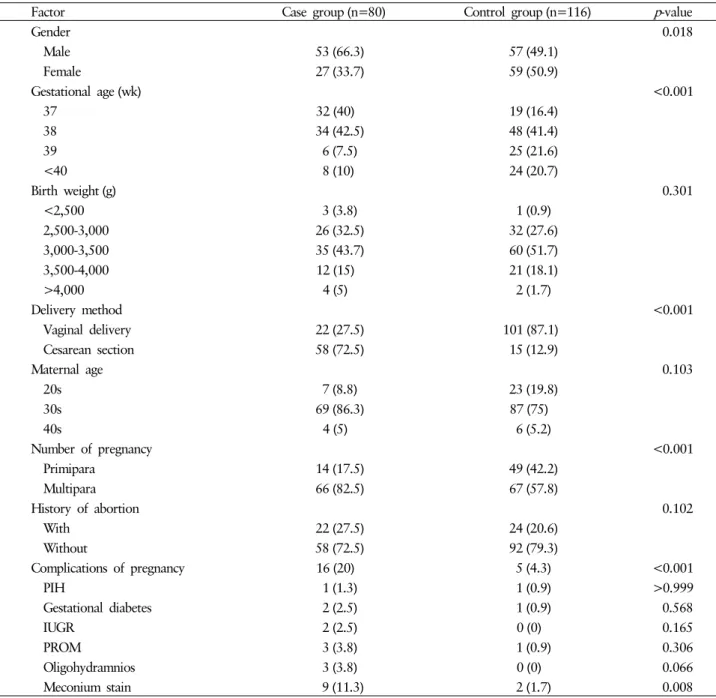Yeungnam Univ J Med 2018;35(2):187-191
Risk factors for respiratory distress syndrome in full-term neonates
Jin Hyeon Kim, Sang Min Lee, Young Hwan Lee
Department of Pediatrics, Yeungnam University College of Medicine, Daegu, Korea
Background: Respiratory distress syndrome (RDS) is a one of the most common cause of respiratory morbi- dity and mortality in neonates. This study was conducted to investigate the risk factors for RDS in full-term neonates.
Methods: We conducted this retrospective study using medical records. The study group included 80 full-term neonates diagnosed with RDS and hospitalized in the neonatal intensive care unit between January 2012 and December 2016, at Yeungnam University Hospital. We analyzed sex, gestational age, birth weight, de- livery method, maternal age, number of pregnancy, history of abortion, and complication of pregnancy. The control group included 116 full-time neonates who were hospitalized with jaundice during the same period.
Results: The incidence of full-term RDS was more common in males (odds ratio [OR], 3.288; 95% confidence interval [CI], 1.446-7.479), cesarean section (OR, 15.03; 95% CI, 6.381-35.423), multiparity (OR, 4.216; 95%
CI, 1.568-11.335). The other factors rendered no significant results.
Conclusion: The risk factors for RDS in full-tern neonates were identified as male sex, cesarean section, and multiparity. Further studies involving more institutions are needed to clarify the risk factors for RDS in full- term infants.
Keywords: Full-term; Neonatal respiratory distress syndrome; Risk factor
Copyright ©2018 Yeungnam University College of Medicine
This is an Open Access article distributed under the terms of the Creative Commons Attribution Non-Commercial License (http://creative- commons.org/licenses/by-nc/4.0/) which permits unrestricted non-commercial use, distribution, and reproduction in any medium, provided the original work is properly cited.
Received: October 18, 2018, Revised: October 29, 2018 Accepted: October 30, 2018
Corresponding Author: Young Hwan Lee, Department of Pediatrics, Yeungnam University College of Medicine, 170, Hyeonchung-ro, Nam-gu, Daegu 42415, Korea Tel: +82-53-640-6999, Fax: +82-53-629-2252 E-mail: yhlee@med.yu.ac.kr
